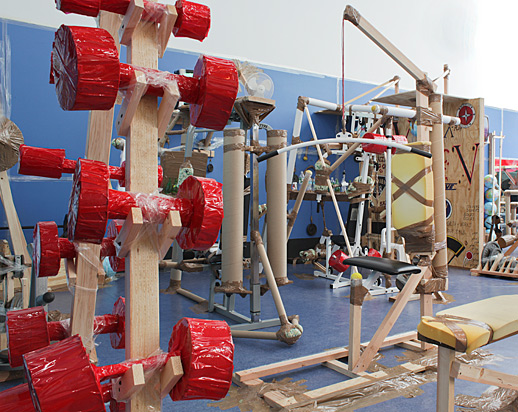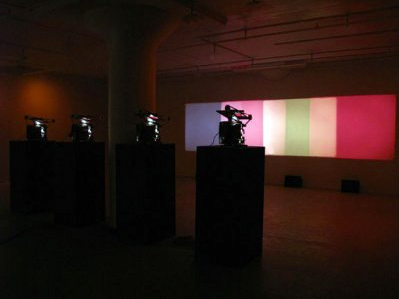more adventures of a gallery hopper
I saw some art last weekend, and felt like there was an unusually large amount of really good stuff to see. Perhaps it's true what they say, about art generally being better in harsh economic climates (or in this case art shows, as most of the actual art was made years or decades ago).

Michäel Borremans' "The Storm" (2006) (at David Zwirner)
A short film loop shows 3 men in the flickering light of a waiting room, about to experience something as either objects or agents. There's a tension here between action and inaction - agency and helplessness - and the tension started working on me as soon as I stepped into the gallery.
---

Jenny Holzer's 'redaction paintings' (at the Whitney)
By transferring declassified government documents to the painted (well, screenprinted) canvas, Holzer turns the common black blots of redacted information into fields of abyssal energy.
---

Thomas Hirschhorn's "Universal Gym" (2009) (at Gladstone)
I took this piece - a life-size installation of a gym, made out of mainly flimsy materials - to be about the experience of having a body: how ridiculous it is that everything we ever experience will be experienced through these porous sacks of flesh; that's how we know the world.
---

Alfredo Jaar's "The Sound of Silence" (2006) (at Galerie Lelong)
A video/sculptural installation which stealthily uses text, light and image to tell the story of a single photograph, which is also the story of African famine, the rise of visual culture, and a troubled photojournalist. I think that Jaar is remarkable at balancing elegy and politics - he's like a poet that way.
---

Tony Oursler exhibition (at Metro Pictures)
Oursler's innovative projected videos have a decidedly offbeat, loony quality to them (at least these days they do - they used to be more severe). I'm not usually that into loony things, but with Oursler you feel some of the edges of a more genuine lunacy.
---

Paul Sharits' "Shutter Interface" (1975) (at Greene Naftali)
Multiple film projectors emit sumptuously pre-digital fields of overlapping color-information. This is why people (including me) are so nostalgic for pre-digital things - lusciousness, tactility, intuitable mechanics, pretty mistakes.

Michäel Borremans' "The Storm" (2006) (at David Zwirner)
A short film loop shows 3 men in the flickering light of a waiting room, about to experience something as either objects or agents. There's a tension here between action and inaction - agency and helplessness - and the tension started working on me as soon as I stepped into the gallery.
---

Jenny Holzer's 'redaction paintings' (at the Whitney)
By transferring declassified government documents to the painted (well, screenprinted) canvas, Holzer turns the common black blots of redacted information into fields of abyssal energy.
---

Thomas Hirschhorn's "Universal Gym" (2009) (at Gladstone)
I took this piece - a life-size installation of a gym, made out of mainly flimsy materials - to be about the experience of having a body: how ridiculous it is that everything we ever experience will be experienced through these porous sacks of flesh; that's how we know the world.
---

Alfredo Jaar's "The Sound of Silence" (2006) (at Galerie Lelong)
A video/sculptural installation which stealthily uses text, light and image to tell the story of a single photograph, which is also the story of African famine, the rise of visual culture, and a troubled photojournalist. I think that Jaar is remarkable at balancing elegy and politics - he's like a poet that way.
---

Tony Oursler exhibition (at Metro Pictures)
Oursler's innovative projected videos have a decidedly offbeat, loony quality to them (at least these days they do - they used to be more severe). I'm not usually that into loony things, but with Oursler you feel some of the edges of a more genuine lunacy.
---

Paul Sharits' "Shutter Interface" (1975) (at Greene Naftali)
Multiple film projectors emit sumptuously pre-digital fields of overlapping color-information. This is why people (including me) are so nostalgic for pre-digital things - lusciousness, tactility, intuitable mechanics, pretty mistakes.